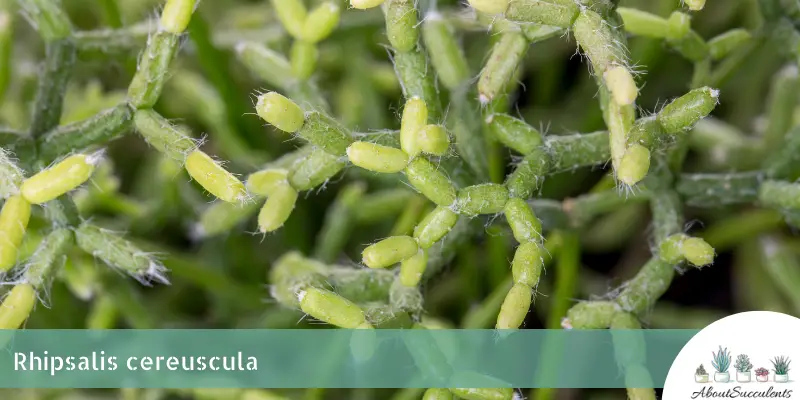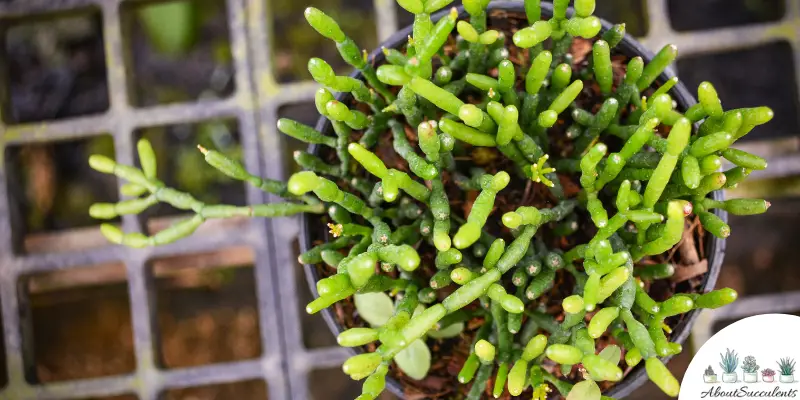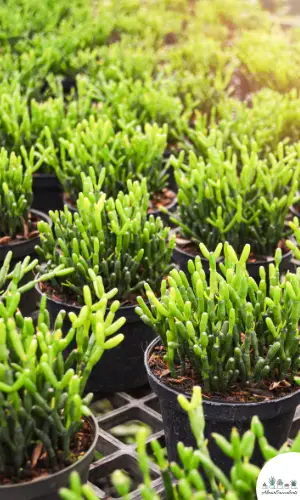
Rhipsalis Cereuscula is a charming, shrubby, and bushy green-colored succulent plant that can brighten up any container garden or give your indoors a cozy, more natural feel.
The light green stems of this succulent are accented with small clusters that look like rice and give the plant the appearance of coral. This is why among the interesting aliases bestowed upon Rhipsalis Cereuscula are Coral Cactus, Rice Cactus, and Mistletoe Cactus.
The stems of Coral Cactus start out straight and measure 90cm (3’) then become pendants as they grow heavier. This is a type of succulent that can bloom throughout the year if it’s properly taken care of.
The flowers of Rice Cactus are bell-shaped, have a greenish-white color, and are often tinged with pink.
Rhipsalis Cereuscula is native to Central and South America. It is popularly grown in Argentina and Brazil. Coral Cactus is a member of the Cactaceae family.
General Information:
Also known as: Coral Cactus, Rice Cactus, and Mistletoe Cactus.
Plant Family: Cactaceae
Origin: Native to Central and South America.
Height: 61cm (24”)
Exposure: Partial sunlight for up to 6 hours.
Water Needs: Only water the soil when it’s 100% dry.
Soil Type: Standard commercial succulent soil or cactus mix with perlite, pumice, or coarse sand added for better drainage.
Soil pH: 5.0 to 6.5
How to Grow and Care for Rhipsalis Cereuscula

Rhipsalis Cereuscula will brighten up your outdoors as a part of a container garden or the indoors as a hanging succulent. It’s an easy succulent to grow and care for if you follow our simple tips below.
Sunlight
Rhipsalis Cereuscula is a type of cactus that can be found underneath trees in the forests of Brazil and thrives better under partial morning sunlight.
When choosing a location for Coral Cactus in your garden, the ideal place would be one that receives partial sunlight for up to 6 hours in the early morning.
You can also plant Rhipsalis Cereuscula in a shaded area or one where sunlight gets filtered by the trees. Avoid exposing this cactus to direct afternoon sunlight.
The same rule applies when growing Rice Cactus indoors. Look for a location that receives only partial sunlight. Go one step further and don’t place the succulent plant too close to the window.
Watering

The good thing about growing Rhipsalis Cereuscula is that you don’t have to hover over it 24/7. It doesn’t require too much water. In fact, when it comes to watering, less is better.
Although a cactus, Rhipsalis Cereuscula is not drought-tolerant. You have to water it but only when the soil is 100% dry. Giving it water when there’s still moisture in the soil will lead to root rotting.
Insert a stick into the topsoil and if the end comes out dry, then get ready to water the succulent. Only water the soil – never the plant – and give it a thorough soaking.
In the wintertime, you will find yourself watering Mistletoe Cactus less because the soil retains moisture longer.
Pot and Soil
Rhipsalis Cereuscula is not a cold-hardy succulent plant. It would be a good idea to plant Coral Cactus in a movable pot if temperatures in your area can drop below -1.1° C ( 30° F).
Choose a pot that’s made of ceramic or terracotta as these types of material allows water to evaporate quickly from the soil. It’s also important to get a pot that has a drain hole with a mesh net cover at the bottom to enable more water to escape.
Standard commercial potting soil and cactus mix are good choices for Rice Cactus. Add materials such as pumice, perlite, and coarse sand to further improve the level of drainage.
How to Propagate Rhipsalis Cereuscula
Are you happy with how Mistletoe Cactus looks in your garden that you plan to add more?
The good news is Rhipsalis Cereuscula can easily be propagated through its stem cuttings.
Method 1: Stem Cuttings
Step 1: Cut off a healthy stem from the main plant by using a pair of sterilized and sharpened garden scissors or a knife.
Step 2: Place the stem cuttings on a warm and dry area and give it 2 to 3 days to develop hard calluses.
Step 3: Once the calluses have formed, plant the stem cuttings on a bed of fresh, well-draining soil.
Step 4: While the roots are making their way into the soil, keep it lightly moist through frequent misting.
Step 5: If the roots have taken hold, water the soil only when it’s completely dry.
Frequently Asked Questions
Is Rhipsalis Cereuscula Toxic to Cats and Dogs?
Rhipsalis Cereuscula is not included in the list of plants that are toxic to cats and dogs that appear on the website of the American Society for the Prevention of Cruelty to Animals (ASPCA).
However, this succulent is a cactus with sap that could cause irritation on the skin and eyes. As a general precautionary measure, keep Coral Cactus far away from your pets.
Why Is My Rhipsalis Cereuscula Dying?
The biggest mistake of succulent growers is to give too much love for Rhipsalis Cereuscula by giving it too much water. That and having invasive pests onboard the plant can lead to Rice Cactus’ death.
Overwatering
Overwatering starts its damage under the soil when the roots are literally bursting with water. Once the cells are destroyed, a type of fungal infection will take place. The infection will quickly move from the roots to inside the plant.
When you see discoloration on the leaves and stems, this is a sign that the infection is working its way outside Rhipsalis Cereuscula. This is why you have to act right away to keep your succulent plant from dying.
Get a pair of sterilized and sharpened garden shears and remove all of the discolored parts of Coral Cactus. Don’t forget to sanitize the garden shears with 70% isopropyl alcohol every time you cut off an infected part of the plant.
Uproot the Rhipsalis Cereuscula and cut out all the roots that have rotted. Let the cactus dry out while you prepare a new pot with fresh, well-draining soil. Re-plant Rice Cactus and give it water only when the soil is certified bone dry.
Pest Infestation
If you see white, cotton-like substances on Rhipsalis Cereuscula, these are evidence that mealybugs and spider mites have made it inside your succulent.
Wipe the substances off with a cotton swab soaked with 70% isopropyl alcohol. Spray the plant with neem oil to keep it pest-free.
Does Rhipsalis Cereuscula Produce Flowers?
When properly taken care of, Rhipsalis Cereuscula produces small flowers that can appear in 3 colors – white, purple, and pink. Coral Cactus can bloom within a year.
Last Updated on June 9, 2022 by Sofia Lara